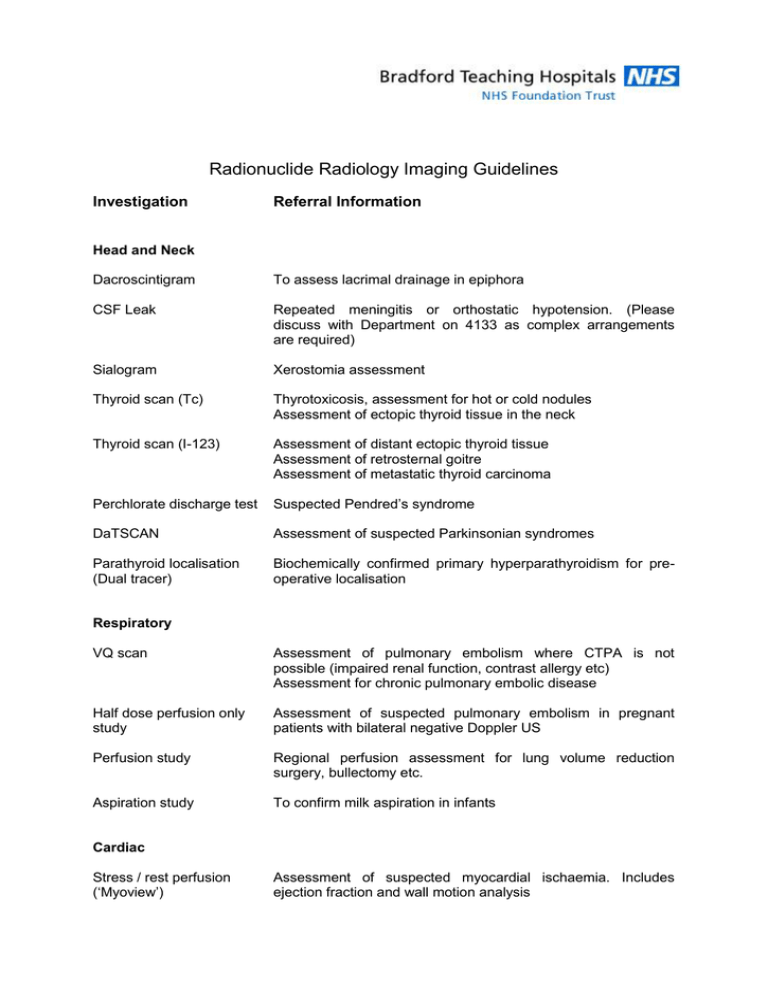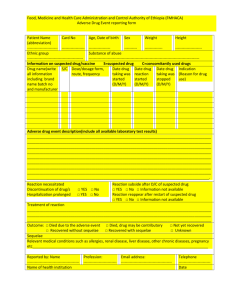Local General Nuclear Medicine Guidelines
advertisement

Radionuclide Radiology Imaging Guidelines Investigation Referral Information Head and Neck Dacroscintigram To assess lacrimal drainage in epiphora CSF Leak Repeated meningitis or orthostatic hypotension. (Please discuss with Department on 4133 as complex arrangements are required) Sialogram Xerostomia assessment Thyroid scan (Tc) Thyrotoxicosis, assessment for hot or cold nodules Assessment of ectopic thyroid tissue in the neck Thyroid scan (I-123) Assessment of distant ectopic thyroid tissue Assessment of retrosternal goitre Assessment of metastatic thyroid carcinoma Perchlorate discharge test Suspected Pendred’s syndrome DaTSCAN Assessment of suspected Parkinsonian syndromes Parathyroid localisation (Dual tracer) Biochemically confirmed primary hyperparathyroidism for preoperative localisation Respiratory VQ scan Assessment of pulmonary embolism where CTPA is not possible (impaired renal function, contrast allergy etc) Assessment for chronic pulmonary embolic disease Half dose perfusion only study Assessment of suspected pulmonary embolism in pregnant patients with bilateral negative Doppler US Perfusion study Regional perfusion assessment for lung volume reduction surgery, bullectomy etc. Aspiration study To confirm milk aspiration in infants Cardiac Stress / rest perfusion (‘Myoview’) Assessment of suspected myocardial ischaemia. Includes ejection fraction and wall motion analysis Myocardial resting redistribution (Thallium) Assessment of suspected hibernating myocardium MUGA (‘MyoLVEF’) Assessment of ejection fraction, particularly with use of cardiotoxic drugs such as Herceptin or cardiomyopathies Cardiac denervation (MIBG) Chronic cardiac ischaemia assessment Occasionally for subclassification of abnormal DaTSCAN results Gastrointestinal Swallow with sucralfate Identification of mucosal inflammation due to reflux where endoscopy is not possible Meckel’s diverticulum Identification of ectopic gastric mucosa HIDA For suspected biliary dyskinesia Assessment of suspected sphincter of Oddi dysfunction post cholecystectomy Assessment of suspected bile leak Assessment of suspected biliary atresia MIBG Assessment of neural crest tumours such as phaeochromocytoma Assessment of disease extent / staging, and response to treatment Assessment for 131I-MIBG therapy Octreotide Assessment of carcinoid tumours Assessment of therapy response Spleen scan (denatured red cells) Identification of accessory splenic tissue / splenosis GI bleed (red cells) Identification of slow active bleeding GI bleed (colloid) Identification of slow intermittent bleeding Hepatic haemangioma Confirm a hepatic haemangioma where CT and US are inconclusive and MRI is not possible Dynamic liver scan Assessment hypertension Gastric emptying Assessment of suspected delayed gastric emptying in solid and / or liquid phase SeHCAT Assessment of suspected bile salt malreabsorption Small bowel study Typically following gastric emptying study for determination of small bowel transit time of suspected post prandial mesenteric Renal MAG3 renogram Assessment of suspected dilated or obstructed renal tracts Assessment of suspected ureteric leak Pre- or post-surgical drainage assessment Drainage and split function assessment Captopril renogram Detection of functionally significant renal artery stenosis where MRI is not possible DMSA Evaluation of cortical scarring Split function assessment Assessment of suspected dromedary hump or focal mass Indirect micturating cystogram With MAG3 renogram to evaluate suspected VUR GFR calculation Accurate GFR calculation for drug monitoring or renal donor selection Transplant assessment therapy purposes, Skeletal Bone scan (+/- SPECT or SPECT-CT) Assessment of metastatic or primary bone malignancy Evaluation of bone and joint pain Evaluation of indeterminate bone lesions Evaluation of benign osseus processes such as Paget’s 3 phase bone scan (+/SPECT or SPECT-CT) Assessment of suspected prosthetic complication Evaluation of bone or joint infection Evaluation of stress fractures or stress reaction Evaluation of bone or joint infection Infection / Inflammation Tc-HMPAO White cell scan Pyrexia of unknown origin (consider FDG PET-CT) Inflammatory bowel disease In-HMPAO white cell scan Suspected prosthetic infection (after positive bone scan, typically with concurrent marrow scan) Reactivated osteomyelitis Haematology Red cell and plasma volume For assessment of primary vs secondary polycythaemia Platelet sequestration Thrombocytopaenic patients considered for splenectomy Miscellaneous Gallium scan PCP in immunocompromised patients with a normal plain film Active vs inactive fibrotic lung disease Assessment of sarcoidosis Please discuss as FDG PET-CT may be more helpful in many situations) Lymphoscintigraphy Assessment of swollen upper or lower limbs in suspected primary or secondary lymphoedema Marrow scan Assessment of marrow redistribution in suspected prosthetic infections (typically with concurrent white cell scan after a positive bone scan) Sentinel node study Assessment of the location of the sentinel node in pre-operative assessment, typically breast cancer, melanoma and squamous cell carcinoma indications PET-CT FDG Oncologic, inflammatory and vasculitis indications. Please click here for current national guidance



